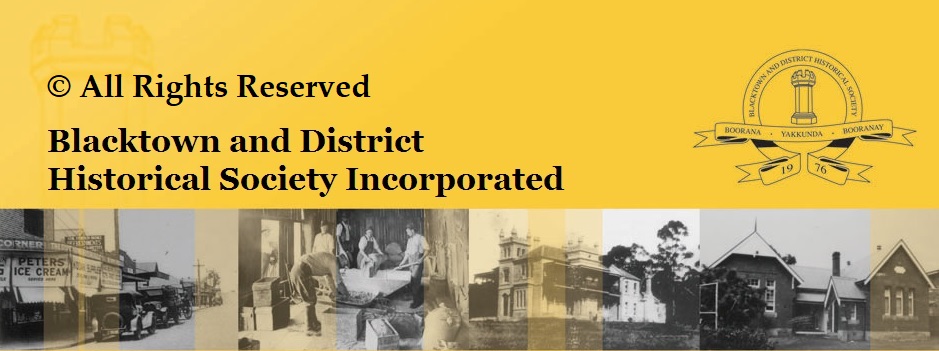
Quarterly Journal Autumn 2017 – Page 3-9
by
Pamela Smith
Local talk suggests that Blacktown’s Robin Hood Inn ceased to exist on the eve of receiving heritage listing. In a shock move, demolishers moved in and took down the entire building overnight in 1984. People familiar with the Robin Hood Inn could not believe their eyes. The building, which was an extensive remodelling of the old Royal Hotel, had stood on its site opposite Blacktown station, for fifty-eight years.
The Robin Hood Inn was the work of well-known architect Cyril Christian Ruwald (1895-1959), who designed hotels for Tooth & Co during the 1930s & 40s. Ruwald designed the Bull and Bush Hotel at Baulkham Hills along the same lines as the Robin Hood. It is clear that Ruwald’s time spent abroad heavily influenced the English styling of both buildings and is reminiscent of what has been termed ‘Inter-War Old English’ architecture.
The Robin Hood Inn opened in 1937. It was actually the result of the remodelling of an earlier hotel on the site The Royal. The Royal Hotel was built in 1889, and in 1912 passed to brewers Tooth & Co Limited. Tooth’s rebuilt it two years later and it became Blacktown’s busiest public house for the next 22 years, due mainly to its handiness to the station. The Royal Hotel closed for remodelling in 1936 and reopened the following year as the Robin Hood Inn.
The ‘new’ hotel’s appointments were intended to satisfy the changing expect the accommodation was almost luxurious by contemporary standards while, in the backyard, horse stables were replaced by three motor garages for the use of guests. ations of travellers
The Robin Hood Inn traded steadily until the early 1980s. The origin of the name was, however, as mysterious as the furtive arrangement of its of demolition in 1984.
In October 1936, Ruwald signed over the contract for the erection of the Robin Hood to the building firm Hutcheson Bros, who were located at Hunter Street, Sydney. A newspaper announcement of the time stated the contractors were rebuilding a “residential hotel at Blacktown to be called the Robin Hood Inn”.
The Construction and Real Estate Journal announced that it was pleasing to see hotels (like the Bull and Bush Inn and Robin Hood Inn) of such high quality erected in country centres of New South Wales. Newspapers in July 1937 also revealed that quite a fanfare surrounded the official opening performed by the president of Blacktown Shire Council, Councillor A L Francis. He congratulated Mrs. Ada Green on the enterprise that realised a building, which was a great credit to the district, and one that marked a “definite step in the progress of Blacktown”. Councillor Francis added that Mrs. Green and her family, who conducted the former Royal Hotel for a decade, had many friends in the district. Responding on behalf of his mother, Eric Green said the building design would provide an atmosphere of rest and comfort commonly found in European hotels.
Sunken gardens graced the entrance to the inn, while the foyer contained arched doorways leading into a private bar furnished with sumptuous leather chairs. Tiles adorned the floor of the public bar that had a “rubber inlaid counter”. The colour scheme for these rooms, and the private lounges and dining room on the ground floor, was “brown, fawn and green.
A carpeted stairway led to an upper storey containing nine bedrooms with toilet facilities. The colour scheme on the first floor was a “pleasing shade of brown” with cream coloured tiles in the toilets. Guests had the advantage of hot and cold running water in every room as well as the use of “delightful sun balconies”. The cellar featured the latest low-pressure gas system for delivering beer to the bar, a refrigerating plant, as well as “the only revolving bottle washer of its kind in the State.
During the 1950s, the Robin Hood Inn was the centre of controversy when the establishment was ‘black-banned’ by a resident group called the Liquor Reform League. The ban was imposed because the League did not agree with Saturday trading hours or the distribution of bottled beer (by ticket) imposed by the licensee. The latter was common in other hotels at the time and created a black market in bottled beer. According to the Tribune newspaper, the situation improved at the hotel after the licensee and the resident group reached an agreement. The licensee agreed to have a minimum of six barrels of beer for Saturday mornings (instead of just three or four); to issue new bottle tickets to requalified patrons; to improve washing of glasses and the number of staff on taps. He also agreed to call for tenders for the beer garden and toilet in accordance with the Licensing Court instructions. The last point of the agreement
stated that drinkers involved in the ban were not to receive unfair treatment.
Stories abound about the unpleasant nature of ‘the 6 0’clock swill’. The state government had imposed 6.00 pm closing for hotels during the First World War as part of Australia’s austerity measures. This situation saw workers leap off their afternoon trains at Blacktown station and rush across the road to the hotel for a very quick beer or two before re-boarding the train. Early closing did not end in New South Wales until 1955. Over the years, news-papers reported instances of illegal gambling on the premises, fines for the serving of liquor out of hours and fines given to desperate men who tried to pass themselves off as travellers. However, the once grand hotel now lives on in the memory of Blacktown residents.
More information – Contact Blacktown & District Historical Society – Website
